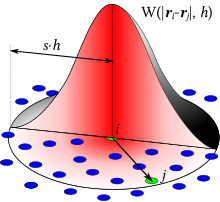
Back Hidrodinàmica de partícules suavitzades Catalan Smoothed Particle Hydrodynamics German Smoothed-particle hydrodynamics Spanish هیدرودینامیک ذرات هموار FA Hydrodynamique des particules lissées French Smoothed Particle Hydrodynamics Japanese Гөлгөржүүлсэн эгэл хэсгийн гидродинамик MN SPH Polish Гидродинамика сглаженных частиц Russian Гідродинаміка згладжених частинок Ukrainian


Smoothed-particle hydrodynamics (SPH) is a computational method used for simulating the mechanics of continuum media, such as solid mechanics and fluid flows. It was developed by Gingold and Monaghan[2] and Lucy[3] in 1977, initially for astrophysical problems. It has been used in many fields of research, including astrophysics, ballistics, volcanology, and oceanography. It is a meshfree Lagrangian method (where the co-ordinates move with the fluid), and the resolution of the method can easily be adjusted with respect to variables such as density.
- ^ Cite error: The named reference
colagrossietal2019was invoked but never defined (see the help page). - ^ Gingold, Robert A.; Monaghan, Joseph J. (1977). "Smoothed particle hydrodynamics: theory and application to non-spherical stars". Monthly Notices of the Royal Astronomical Society. 181 (3): 375–89. Bibcode:1977MNRAS.181..375G. doi:10.1093/mnras/181.3.375.
- ^ L.B. Lucy (1977). "A numerical approach to the testing of the fission hypothesis". Astron. J. 82: 1013–1024. Bibcode:1977AJ.....82.1013L. doi:10.1086/112164.